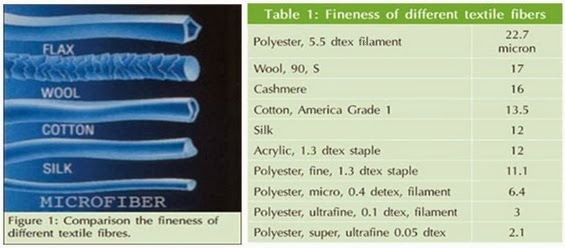What is Micro Fiber?
Microfiber or microfiber is synthetic fiber finer than one or 1.3 denier or decitex/thread. This is 1/100th the diameter of a human hair and 1/20th the diameter of a strand of silk. The most common types of microfibers are made from polyesters, polyamides (e.g., nylon, Kevlar, Nomex, trogamide), or a conjugation of polyester, polyamide, and polypropylene (Prolen).Microfiber combines two basic fibers, Polyester and Polyamide (a Nylon by-product). These fibers are usually “split” and formed into a woven fabric of 80% Polyester (the scrubbing and cleaning fiber), and 20% Polyamide (the absorbing and quick drying fiber).
These threads are very small in diameter making them super soft. Rated in denier, the unit for measuring fineness of fabric, a strand of cotton has a rating of 200. A human hair has a denier of 20 and a strand of silk has a denier of 8. Microfiber has a denier of 0.01 to 0.02! At minimum, 100 times finer than a human hair. Softer than silk, yet bull-dog tough, split Microfiber cloth attracts dust, grime, oily films and salt residues like a magnet.
The unique surface structure of split Microfiber cloth contains hundreds of thousands of micro fiber “hooks” per square inch! These micro-hooks grab, lift, and hold dust and grime without the need for cleaning solutions. Microfiber cloth can be used damp or dry. Used dry, Microfiber cloth works like a chamois. The super absorbent weaves holds up to seven times its weight in fluid and will not scratch paint, glass, acrylics or plastic window tint films.
Properties of Microfibres
Microfibers are made solely from man-made fibers. They are the finest of all the fibers. Sportswear from microfibers functions particularly well. It is breathable and at the same time provides reliable protection against wind and rain. Fashionable apparels in microfibers have graceful flow, silk-like feel and are extremely comfortable. Microfiber clothing is not sensitive, retaining its positive qualities after washing or cleaning.
 |
| Comparison of microfiber with other textile fiber |
- Ultra-fine linear density (less than 0.1 dtex/f), finer than the most delicate silk.
- Extremely drapeable & Durability.
- Very soft, luxurious hand with a silken or suede touch.
- Washable and dry-cleanable.
- Shrink resistance.
- High strength, although the filaments are super fine.
- Insulates well against wind, rain and cold.
- Anti-microbial agents help to protect both family members and work staff from the dangers of the bacteria that cause odor and mildew.
- Microfibre is hypoallergenic, and so does not create problems for those suffering from allergies.
- Microfibre is non-electrostatic.
- Microfibres are super-absorbent, absorbing over 7 times their weight in water.
- Microfiber dries in one-third of the time of ordinary fibres.
- Microfibres are environmentally friendly
- Improved breathability
- Vivid prints with more clarity and sharper contrast
- Appearance retention
- Can be made windproof and water resistant
- The greater fiber surface area also results in higher rates of dyeing at lower temperatures, and decreased fastness to light, crocking (fastness to rubbing), water & ozone.



 02:29
02:29
 vishnu
vishnu

 Posted in:
Posted in: 


.jpg)




0 comments:
Post a Comment